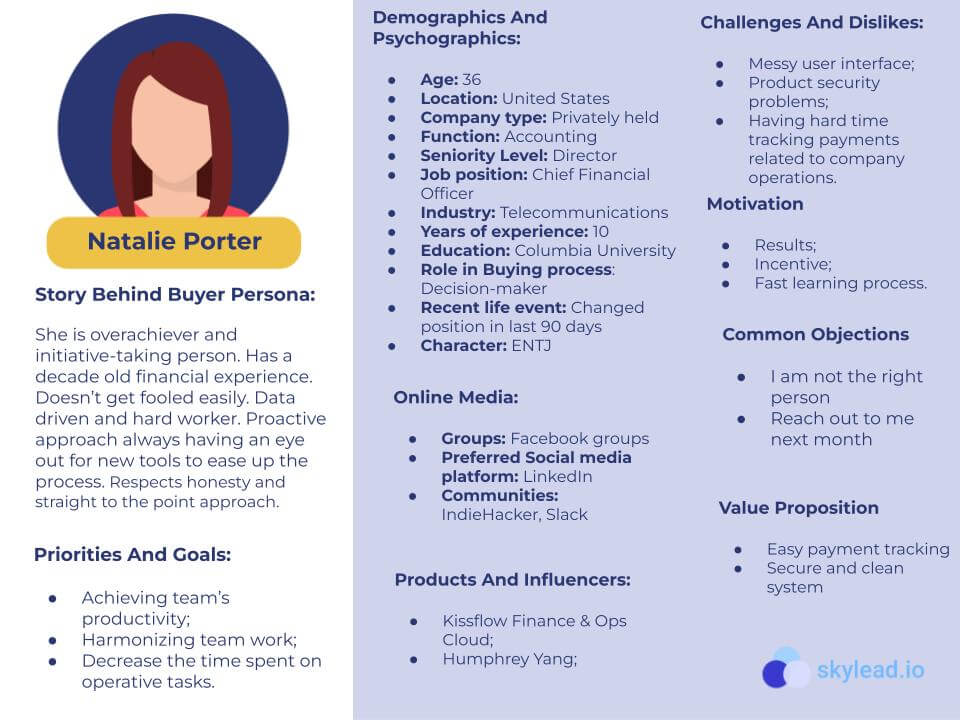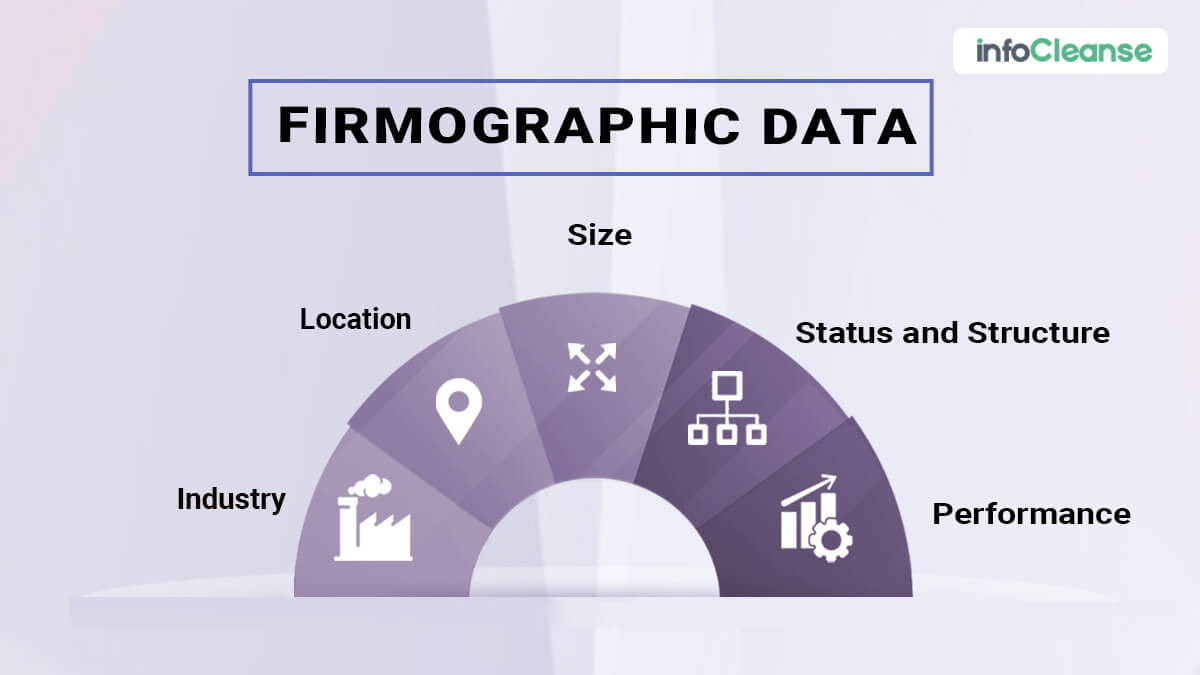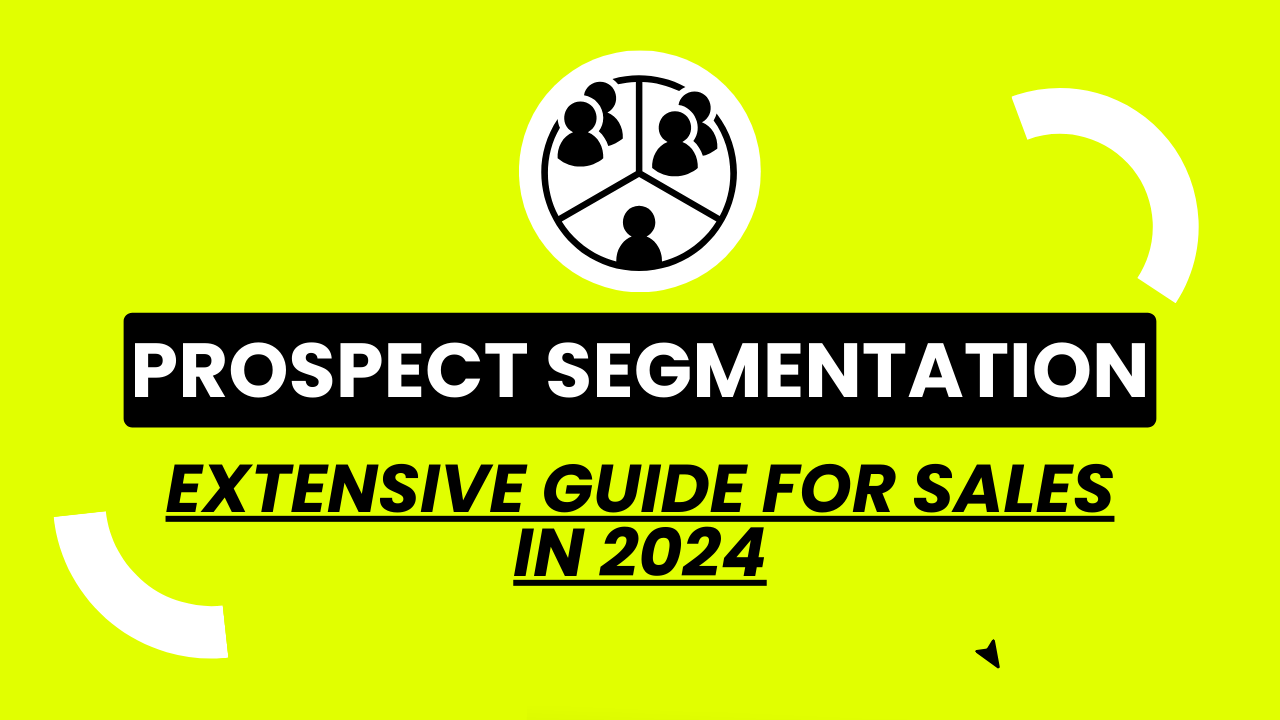Picture this:
You’re sitting down with your favorite coffee, scrolling through your inbox.
Then, out of nowhere, you’re hit with sales emails that just don’t fit you.
Offers for things you don’t need or want.
It’s like someone’s guessing what you like, but they’re getting it all wrong.
Offers for baby products, and you don’t even have kids. Invitations to join a seniors’ fitness club when you’re barely thirty. It’s like a barrage of arrows missing their target.
Now, imagine you’re on the other side of this – the one sending these off-target pitches.
It’s a classic case of misfired ambition, a wasteful scattergun approach that makes your prospects feel misunderstood and, frankly, a little annoyed.
The secret to avoiding this?
It’s simple yet profound – Prospect Segmentation.
It’s not just a fancy term, no. It’s the lifeline for any sales strategy that seeks relevance and results.
Ready to rock and roll?
Let’s dive into how Prospect Segmentation can totally revamp your sales strategy in 2024.
And trust us, it’s a game changer!
Summary
Get ready to give your sales a turbo boost with Prospect Segmentation!
In this blog guide, we’ll walk you through what Prospect Segmentation is and why it’s a big deal for ramping up your sales.
We’ll cover the top reasons it’s essential for growth, including how it streamlines your sales process, boosts conversion rates, and increases revenue.
Then, we’ll get into the nitty-gritty of how to segment your prospects effectively.
We’re talking about buyer personas, firmographic data, behavioral insights, funnel stages, and understanding their pain points.
Plus, we’ll show you how to prioritize prospects to maximize your sales efforts.
Lastly, we’ll introduce you to ZeroIn and how it can be your ally in achieving your sales goals.
What is Prospect Segmentation?

Prospect Segmentation is the process of dividing potential customers into distinct groups based on shared characteristics or behaviors with the goal of creating more targeted and effective sales strategies.
Think of it like organizing your closet.
You wouldn’t mix your gym clothes with your work outfits, right?
In the same way, Prospect Segmentation is about sorting your potential customers into groups.
But instead of clothes, you’re sorting people based on what they like, need, and how they behave.
In simpler terms, it’s grouping your prospects into different categories.
These groups are based on things like what job they have, where they live, or what they’re interested in.
This helps you understand them better.
When you know what each group likes, you can create messages that speak directly to them.
Think of it like this: You wouldn’t talk to a teenager the same way you’d talk to a retiree. Each group has different interests and needs. Prospect Segmentation helps you to tailor your approach so that you’re talking to the right people in the right way.
In short, it’s all about getting to know your potential customers and organizing them into groups so you can connect with them better. This way, your sales messages hit the mark more often than not.
Why is Prospect Segmentation crucial for Sales Growth?
The difference between those who are killing it in sales and those who aren’t is that those who do, know who to talk to, when, and how.
And one thing that can be extremely helpful for this is prospect segmentation.
Let’s take a look at 3 main reasons why prospect segmentation is crucial for sales growth.
Reason #1 Streamlined Sales Process
The first reason why prospect segmentation is vital lies in its ability to streamline your sales process.
When you segment your prospects, you’re essentially putting order into what can often be a chaotic process. It’s like having a map in a large, unfamiliar city. You know exactly where to go, the fastest routes to take, and the areas to avoid.
With a well-segmented list, your sales team can focus their efforts where it counts. They spend less time guessing and more time connecting with the right people. This means they can tailor their pitches, make their phone calls and cold emails more personal, and hit the right notes that resonate with each specific group.
In essence, a streamlined sales process is more efficient, less time-consuming, and, most importantly, more effective.
Reason #2 Higher conversion rates
The second reason for adopting prospect segmentation is the potential for higher conversion rates.
It’s straightforward: when your sales messages are targeted to the right group, they’re more likely to hit home.
This approach is far more effective than casting a wide net and hoping for the best.
Segmented marketing means you’re speaking directly to someone’s needs, desires, and pain points. It’s the difference between a generic, impersonal flyer and a personalized letter that addresses the recipient by name and touches on their specific interests.
When prospects feel understood and see that your products or services solves their unique problems, they’re more inclined to buy.
This tailored approach naturally leads to a higher success rate in turning prospects into paying customers.
Reason #3 Increased Revenue
The third and perhaps most impactful reason for leveraging prospect segmentation is the direct line it draws to increased revenue.
It’s simple math – better targeting plus higher conversion rates equals more sales.
When you speak directly to the needs and wants of a well-defined group, your chances of closing a deal skyrocket. This targeted approach means you’re not wasting resources on uninterested parties. Every marketing dollar and sales effort is used more efficiently.
More importantly, when customers feel that your offerings are tailor-made for them, they’re not only more likely to buy but also willing to pay a premium for products or services that seem custom-tailored to their needs.
In the long run, this means a healthier bottom line and a more robust, sustainable business model.
How to Properly Segment Your Prospects?
Knowing the importance of prospect segmentation is one thing, but understanding how to do it effectively is where the real magic happens.
In this section, we’ll dive into the practical steps and strategies to segment your prospects efficiently. We’re not just talking theory here, we’re giving you actionable insights to categorize your potential customers in ways that will amplify your sales efforts.
Let’s roll up our sleeves and get to work.
Segmentation Thru Buyer Persona Division
The first step in effective prospect segmentation is creating buyer personas.
Think of these as detailed sketches of your ideal customer profile.
Each persona represents a different segment of your target market, characterized by specific traits, behaviors, and preferences.
To build these personas, start by gathering data – the more, the better.
Look at demographics like age, gender, location, work, and years of experience.
Dive into psychographics like interests, values, and lifestyle.
And don’t forget to consider their pain points, challenges, and goals.

By constructing these detailed personas, you equip your sales team with a deeper understanding of who they’re selling to.
This isn’t just about grouping people – it’s about getting to the heart of what makes different customers tick.
Armed with this knowledge, your team can tailor their approach to resonate with each specific persona, making your sales efforts more focused and far more likely to get engagement.
Utilizing Firmographic Data
Next up in fine-tuning your prospect segmentation is using firmographic data.
Just as demographics are crucial for individual customers, firmographics are key for understanding the companies you’re targeting.

Start by looking at the company size. Are you targeting small startups or massive enterprises?
Next, consider the industry they operate in – each has its own unique challenges and needs.
Location matters too, a business in a bustling city might have different priorities than one in a rural area.
Annual revenue, funding status, and total funding give you insight into a company’s financial health and investment capabilities. Are they a well-established player or a new kid on the block? Understanding their IPO status and years in business helps in gauging their market stability and growth trajectory.
Don’t overlook the company structure and ownership. Are they a family-owned business, a corporation, or a non-profit? Each has different decision-making processes and values.
Technographic information sheds light on the technology they use, which can influence their needs and pain points.
Lastly, consider what types of products or services they offer. This can give you clues about their business model and potential needs.
By dissecting these firmographic elements, you can create lead segments in your CRM that are remarkably tailored to the types of business profiles you’re aiming to attract, making your B2B prospecting strategies more relevant and effective.
Behavioral Segmentation
Behavioral segmentation dives into the ‘how’ and ‘why’ behind customer interactions.
Here you are categorizing your prospects based on their actions and responses. Things like how people engage with your products, website, or even how often they do business with you.
Are they frequent buyers or once-in-a-blue-moon shoppers? Do they spend a lot of time browsing your website, or do they make quick, decisive purchases?
Also, look at the frequency and pattern of their interactions. Some customers might engage with your app or website daily, while others might only show up when there’s a sale or a new product launch.
Understanding these behavioral patterns allows you to tailor your sales and marketing efforts more effectively which which leads to more personalized, impactful sales approaches, ultimately converting more prospects into loyal customers.
By Stage in your Funnel
Since you’re delving into this guide, let’s assume you’ve got a grasp on the sales funnel.
Perhaps you’re even segmenting your prospects based on their funnel stage. If that’s already part of your process, great! If not, no worries – it’s never too late to start, and it’s crucial not to overlook this strategy.
Segmenting by funnel stage means aligning your approach with where the lead is in their buying journey.
In the simplest terms, a basic B2B sales funnel includes TOFU (Top of Funnel), MOFU (Middle of Funnel), and BOFU (Bottom of Funnel).

At TOFU, you’re dealing with prospects who are just getting to know your product or service. They’re in the awareness phase, so your focus here is on educating and informing.
Moving down to MOFU, these prospects are considering their options – they know they have a need and are evaluating how to fulfill it. Here, your content should help them understand why your solution is the best fit.
Finally, at BOFU, prospects are ready to make a decision. This is where your sales efforts need to be most persuasive and reassuring, providing that final nudge towards a purchase.
By segmenting your prospects according to these stages, you can tailor your messaging and strategies to be more relevant and effective at each point in their journey.
This alignment not only makes your sales process more efficient but also significantly increases the likelihood of converting prospects into customers.
Problems and Painpoints
Any basic business course, book, or even a cursory glance at a business-focused YouTube video will tell you this: your product or service should solve a specific problem for a specific audience.
And, at the heart of every ‘problem’ is a pain point, an itch that needs scratching.
Why we are telling you this?
Here’s why:
if you haven’t pinpointed a significant problem your product addresses for a particular audience, your business venture is on shaky ground.
On the flip side, if you’ve got this figured out, your chances of success are much higher.
Before reading further take a moment and think deeply about this.
Now, you might wonder, how can you segment customers based on pain points and problems if your product solves just one major issue?
It’s simple, yet not so straightforward.
Your primary customer base might buy your product for one key reason, but there’s often a secondary audience that purchases it for entirely different reasons.
This is where nuanced segmentation comes into play.
Here you need to understand not just the overarching problem your product solves but also the various pain points it alleviates for different customer segments.
For example, a project management tool might primarily help in organizing tasks (its main problem-solving feature), but for some users, its real value could be in time tracking or team communication.
By identifying these varied reasons people turn to your product, you can tailor your marketing and sales approaches to address these specific pain points. This approach ensures that your messaging resonates more deeply with each segment, increasing the likelihood of conversion and fostering customer loyalty.
How to Prioritize Your Prospects?
Now that you’re equipped with strategies to segment your prospects, the next vital step is figuring out how to prioritize them.
Here’s a reality check: you likely don’t have unlimited resources to cover every segment effectively.
Even if resources weren’t an issue, spreading them too thin across all segments isn’t the wisest strategy.
So what is?
Prioritizing your prospects.
What this means is focusing your efforts where they’re most likely to yield fruitful results. And while this is a topic that can fill its own guide, and we’ve done just that in our detailed article on ‘How to Prioritize Sales Leads?’, here are a few pointers to get you started.
1. Look at potential revenue: Prioritize prospects that promise higher returns.
2. Assess the likelihood of conversion: Focus on those who are more likely to make a purchase.
3. Consider the sales cycle length: Shorter cycles might mean quicker wins.
4. Evaluate relationship potential: Long-term client relationships can be more valuable than one-off sales.
At the end of the day, when you take all these factors into account and create your own criteria for the type of company profiles you’ll go after, you’ll be able to focus on those that are most important to your business.
This is the most effective way to prioritize leads.
This approach enables you to channel your efforts into nurturing the prospects that are not only more likely to convert but also align best with your business goals and resources.
By doing so, you create a strategic, focused path for your sales team, leading to more efficient and successful outcomes.
How can ZeroIn help you reach your Sales Goals?
Having your prospects segmented and prioritized is a solid start, but reaching out to them is a different ball game.
Whether it’s through email campaigns, LinkedIn messages, or direct phone calls, you need accurate contact information. And let’s face it, manually hunting down email adresses and other details for a hundred prospects in one segment isn’t just tedious – it’s impractical.
This is where ZeroIn – a business email finder and LinkedIn data export tool steps in to make your life easier.
Look, ZeroIn isn’t just a tool – it’s a powerhouse for your outreach strategy, especially when dealing with segmented and prioritized leads.
Let’s take a look at how ZeroIn can revolutionize your approach:
1. Rich, Verified Data: ZeroIn doesn’t just give you names and emails. It offers a comprehensive set of data, with business emails verified in real-time. This means your outreach efforts are more likely to land in the right inbox and get a response.
2; GDPR Compliance: In today’s data-sensitive world where everyone is concerned with privacy, ZeroIn keeps you on the safe side of regulations. It’s fully aligned with GDPR, ensuring that the data you use is both ethical and compliant.
3. High Accuracy Rate: With a 98% accuracy rate, ZeroIn stands out as a reliable source. This accuracy is crucial when you’re reaching out to segmented groups, ensuring that your message is relevant and timely.
4. Extensive Data Points: Offering 26 data points on leads and companies, ZeroIn gives you a detailed picture of your prospects. This depth of information allows for a more targeted approach in your communication.
5. Vast Database Access: With access to over 200 million contacts, ZeroIn opens up a world of potential leads. This extensive database means you’re more likely to find the ideal prospects within your segmented groups and learn more about them.
In short, ZeroIn is more than just a data finder. It’s an integral part of a smart sales strategy, helping you connect with segmented prospects efficiently and effectively.
With ZeroIn, the tedious task of gathering contact information becomes a breeze, allowing you to focus on what you do best – selling.
You can try it out for free but…
Be careful!
It’s so good you wouldn’t be able to imagine sales prospecting without it!
Conclusion
Alright, let’s land this plane.
We started this blog with a pretty clear picture: getting bombarded with sales pitches that miss the mark.
Annoying, right?
That’s the mess we want to avoid.
Prospect Segmentation – it’s our way out of this.
And it’s not just another piece of jargon.
No.
It’s about truly understanding who’s on the other end and what they’re all about.
Think of it as the secret sauce in your sales strategy, making sure you’re not just throwing stuff out there and hoping it sticks but rather helping you strike the right chords with the right folks.
This is what makes the difference, what turns an okay sales plan into a great one.
So, as you step into your next sales strategy meeting or plan your next campaign, keep it simple.
Remember, it’s all about talking to the right people in a way that makes them think, “Hey, they get me!”
That’s Prospect Segmentation in a nutshell – and it’s your ticket to nailing sales in 2024.
Now go out there and show them what you’ve got!
FAQs
What is Prospect Segmentation?
Prospect Segmentation is the process of dividing potential customers into distinct groups based on shared characteristics or behaviors with the goal of creating more targeted and effective sales strategies.
Why is Prospect Segmentation crucial to Sales Growth?
Prospect Segmentation is crucial for sales growth because it aligns your sales strategy with your customers’ specific needs and behaviors, leading to more efficient and effective results.
Here’s a quick rundown:
Streamlined Sales Process: Segmentation organizes your sales approach, helping your team focus on the right prospects. This leads to more personalized interactions and efficient use of time and resources.
Higher Conversion Rates: Tailoring your message to specific segments means addressing their unique needs, resulting in a higher likelihood of converting prospects into customers.
Increased Revenue: Targeted outreach to well-defined groups boosts sales success and customer willingness to pay, ultimately enhancing your bottom line.
In essence, Prospect Segmentation turns your sales efforts into a precise, customer-focused approach, fueling growth and success in your business.
How to Properly Segment Your Prospects?
To properly segment your prospects, it’s crucial to understand and apply different segmentation methods that resonate with your target audience. Here’s a brief overview:
1. Buyer Persona Division: Create detailed profiles of your ideal customers based on demographics, psychographics, and their challenges. This helps in crafting personalized sales strategies.
2. Firmographic Data: Use company-related data like size, industry, and financial status to segment B2B prospects. This aligns your approach with the specific needs of different businesses.
3. Behavioral Segmentation: Observe and categorize prospects based on their interaction with your website and other channels. This helps in understanding their purchasing habits and preferences.
4. Stage in Sales Funnel: Segment prospects based on where they are in the buying journey, from awareness to decision-making. This allows for tailored messaging at each stage.
5. Problems and Pain Points: Identify and address the specific problems or needs of different prospect segments. This ensures your products or services are seen as a relevant solution.
By combining these methods, you can segment your prospects effectively, leading to more targeted sales approaches and improved conversion rates.
How to Prioritize Your Prospects?
Prioritizing your prospects is key to maximizing your sales efforts efficiently. Here’s a quick guide to get you started:
– Potential Revenue: Put focus on prospects that offer higher financial returns. This means targeting those who are likely to make larger or more frequent purchases.
– Likelihood of Conversion: Concentrate on prospects who show a higher probability of buying. These are the ones who engage more with your marketing or sales initiatives.
– Sales Cycle Length: Give priority to prospects with shorter sales cycles for quicker wins. This helps in maintaining a steady flow of sales.
– Relationship Potential: Consider the long-term value of prospects. Those who may develop into recurring customers or brand advocates are often worth the investment.
By considering these factors, you can effectively prioritize your prospects, ensuring that your sales team focuses on the most promising opportunities. This strategic approach leads to more efficient use of resources and better sales outcomes.
How can ZeroIn help you reach your sales goals?
ZeroIn is an email business finder that streamlines your outreach strategy, especially when dealing with segmented and prioritized leads. Here’s how it helps in reaching your sales goals:
Rich, Verified Data: ZeroIn provides comprehensive data sets including real-time verified business emails. This ensures your outreach efforts are more likely to be successful.
GDPR Compliance: ZeroIn email finder aligns with GDPR regulations, ensuring the data you use is both ethical and compliant.
High Accuracy Rate: With a 98% accuracy rate, ZeroIn ensures the reliability of the data, making your outreach efforts relevant and timely.
Extensive Data Points: With 26 data points on leads and companies, ZeroIn offers detailed insights into your prospects, allowing for more targeted communication strategies.
Vast Database Access: Access to over 200 million contacts enhances your chances of finding the ideal prospects within your segmented groups.
In essence, ZeroIn simplifies the process of gathering contact information, making your sales efforts way more efficient and effective.
